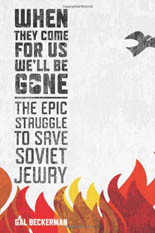
IRIS login | Reed College home Volume 90, No. 1: March 2011
Trapped in the USSR (continued)

During a recent interview in New York City, Gal displayed the intellectual intensity for which Reed is famous. Dressed in a dark blue blazer and open-necked button-down shirt, he looked as if he had just stepped out of a classroom.
“What’s special to me about this movement is that it combined—and this is a Reedie way of putting it—it combined the universal and the particular,” he says, referring to the universality of human rights with the particularity of a Jewish cause.
The story he details is a tale of ordinary activists in two countries. In the United States, he focuses on how small groups of Jews, first in Cleveland and then in New York City, adopted the cause of the Soviet Jews—known as refuseniks because they were refused permission to emigrate—and catapulted it onto the agenda in Washington. Indeed, the issue helped coalesce the American Jewish community into the powerful political force it is today.
Meanwhile, Soviet Jews faced a more existential challenge. “In Stalin’s period and after, it was almost impossible to maintain a semblance of Jewish identity,” Gal says. “By the ’60s, people were coming of age, and their connection with what it meant to be Jewish was their grandfather who would go once a year to the decrepit old synagogue in the city and pray, or a grandmother who knew how to make gefilte fish or light some candlesticks. But, what did keep them aware of themselves as Jews was this stamp on their passport,” referring to the line on Soviet passports that identified their nationality.
Relying on dozens of oral interviews with Soviet émigrés, Gal shows how they secretly maintained their Jewish identities. Many of them paid a terrible price. Mendelevich and better-known refuseniks like Anatoly (now Natan) Shcharansky lost their jobs and were imprisoned in the Gulag for their desire to learn Hebrew, observe religious customs, and immigrate to countries where they could practice Judaism freely.
Two historical factors contributed to the movement’s launch: the Holocaust (many of the refuseniks building the memorial at Rumbuli were motivated to do so because they lost relatives to the Nazis or their collaborators) and the “thaw” ushered in by Soviet leader Nikita Krushchev in the late 1950s and early 1960s, which gave Jews and other dissidents just enough public space to organize.
The movement’s first big victory came in 1975, when President Gerald Ford signed the Jackson-Vanik Amendment, which made freedom of emigration a requirement for most-favored nation trade status—a direct challenge to Soviet policy. That legislation cracked open the floodgates. Starting in 1976, more than 1.5 million Jews left the Soviet Union and its successor states, emigrating mainly to Israel and the United States.
“I don’t think it’s an overstatement to say that this is one of the overlooked, but most successful, human rights campaigns of the twentieth century,” Gal says. “It was a campaign that started from nothing—with student groups and people who cared about this issue—and led to a global cause where you had Reagan pulling out a list of names every time he would meet with Gorbachev.”
Weighing in at 598 pages, the book required a prodigious amount of research conducted on three continents. Back home in Brooklyn, where he lives with his wife and daughter, who turned one in October, Gal is thinking over his next project. He hasn’t reached a final decision but does know one thing: “It will be a lot shorter.”
Further Reading
When They Come for Us, We’ll Be Gone: The Epic Struggle to Save Soviet Jewry by Gal Beckerman. Houghton Mifflin Harcourt, 2010.
- Previous Page
- 1
- 2
- Next Page


LATEST COMMENTS
steve-jobs-1976 I knew Steve Jobs when he was on the second floor of Quincy. (Fall...
Utnapishtim - 2 weeks ago
Prof. Mason Drukman [political science 1964–70] This is gold, pure gold. God bless, Prof. Drukman.
puredog - 1 month ago
virginia-davis-1965 Such a good friend & compatriot in the day of Satyricon...
czarchasm - 4 months ago
John Peara Baba 1990 John died of a broken heart from losing his mom and then his...
kodachrome - 7 months ago
Carol Sawyer 1962 Who wrote this obit? I'm writing something about Carol Sawyer...
MsLaurie Pepper - 8 months ago
William W. Wissman MAT 1969 ...and THREE sisters. Sabra, the oldest, Mary, the middle, and...
riclf - 10 months ago